Although it’s been featured on TV (e.g., The Travel Channel’s Mega Mansions), and in books and magazines, The Mansion on O Street (2020 O Street NW, Washington, DC) has to be one of the coolest museums many people have never heard of.
When I say it’s cool, that’s not just my opinion – the so-called “O museum” has been recognized as a top cool and historic place by booking.com and Smithsonian Magazine, and listed as a Top Hotel in DC by Forbes (did I mention it’s also a hotel?). I had lived in the DC area for 15 years, oblivious to its existence, before visiting the mansion for a business meeting.
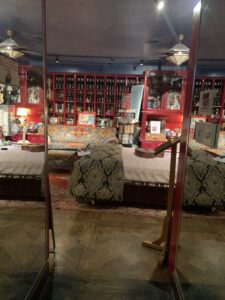
When I recently proposed making a family trip there, my husband – who grew up in the DC area and has lived here 80 percent of his life – said, “the what?”
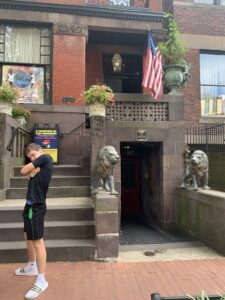
It sits quietly as a nondescript set of connecting brownstone townhomes on a nice but not over-the-top DC city block in Dupont Circle with only a sign announcing its existence. Once you step though the front door, however, you are quickly enveloped into one of the most unique experiences you’ll find in DC, and maybe anywhere.
The O museum was designed in the late 1800’s, constructed and lived in by Edward Clark, the architect for the US Capitol. It is, above all, two things. First, it’s ginormous – more than 100 rooms spread across five large townhomes. 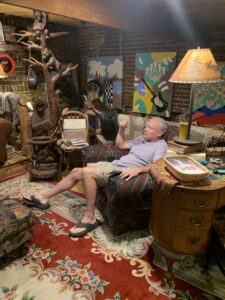 And it secondly, it’s creativity on a possibly unprecedented scale – featuring themed rooms from one end to the other and from top to bottom, such as a two-floor Log Cabin, Mrs. Rosa Parks’ room (where she lived for nearly 10 years), John Lennon Suite, Halloween themed room, and many others. These themed rooms are both diverse in architectural styles and packed with relevant paraphernalia that you can BUY! And if you get tired from touring and losing yourself in the mansion, you can just book a room and spend the night in one of the themed rooms (just kidding – you probably have to book ahead).
And it secondly, it’s creativity on a possibly unprecedented scale – featuring themed rooms from one end to the other and from top to bottom, such as a two-floor Log Cabin, Mrs. Rosa Parks’ room (where she lived for nearly 10 years), John Lennon Suite, Halloween themed room, and many others. These themed rooms are both diverse in architectural styles and packed with relevant paraphernalia that you can BUY! And if you get tired from touring and losing yourself in the mansion, you can just book a room and spend the night in one of the themed rooms (just kidding – you probably have to book ahead).
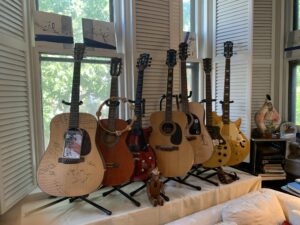 From artwork to sports, music, and movie memorabilia (e.g., Miss USA’s crown, Bob Dylan’s Rock Roll Hall of Fame induction signed guitar – and many, many other guitars, Prince’s Purple Rain Jacket and the flag that flew on the Merrill Lynch office on 9-11), the O museum is dedicated to the creative process. This and its other singularly unique feature – nearly 80 secret doors – makes it (almost) the perfect place for a neurodiverse family outing.
From artwork to sports, music, and movie memorabilia (e.g., Miss USA’s crown, Bob Dylan’s Rock Roll Hall of Fame induction signed guitar – and many, many other guitars, Prince’s Purple Rain Jacket and the flag that flew on the Merrill Lynch office on 9-11), the O museum is dedicated to the creative process. This and its other singularly unique feature – nearly 80 secret doors – makes it (almost) the perfect place for a neurodiverse family outing.
It’s an immersive and tactile experience that feels like you are walking through the rooms of a house, the music and lighting levels are manageable, food is available on site, and from the moment you walk through the front door, the staff are very helpful and accommodating.
The only downside is that kids can get so excited, they find and take off through a secret door and you’ve momentarily lost them in the labyrinth.
We tried our best to stay together but had to ultimately give them a little bit of freedom, keep up by texting and they always seemed to know where each other was.
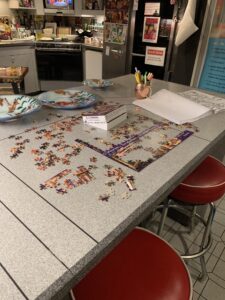
Here are reviews by two of our kiddos:
Jeffrey’s View:
It was very, very fun – it was like a hidden door museum. I found like 26 of the secret doors. My favorite rooms were the log cabin and maybe the basement, with a medieval dining room. The only problem with it is you don’t have a sheet that shows you what is a hidden door – like one of the windows we found might have been a hidden door, but it might not, so you don’t know exactly what is a hidden door. They could have a piece of paper with all the doors listed, and maybe a description, since some of them aren’t obvious. It’s possibly the best museum in DC – it’s definitely up there. I would honestly recommend it to your school for a field trip [Group Student tours are welcome]. I would tell who visit to keep an eye out for anything! 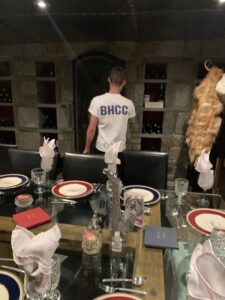
Emma’s View:
Jeffrey found a lot of doors and I did a lot of coloring when I found doors – a lot of the rooms had coloring pages and books and I would just sit there and color. I thought all the rooms were pretty cool – it had more rooms than most other museums and a lot of them were decorated – like one room looked like backstage at a concert and it was like you had a backstage pass.
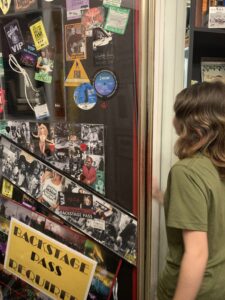
There was also one room where there were so many Halloween animatronics. At first, I was scared to go in – but then I figured out if you clap twice it would go from complete darkness to everything lit up, and a random person would come up in the room and say, there’s a Chucky in this room, can you find him? I would wonder, where did they come from? There are no other doors to get into this room.
The room themes spanned decades and eras. It was hard to think how people came up with the ideas in the O museum and put them into action – each room had thousands of dollars of things, tons of books [in fact a collection of 20,000 books]. Sometimes it was hard to find the secret doors, then a toddler would come out of nowhere and finds one – little kids are touching and pulling on everything so they could sometimes find them when I couldn’t. I still really like the International Spy Museum – which would show what it was like if you were a spy for the US and in Russia during Cold War. I would say it was mid-high tier on my list – it was sometimes frustrating – you’d be trying to get out, go through a door and you’d be in the middle of the building. I remember one time Jeffrey said, Emma I found a hidden door, but it was a ventilation room. It was unlike anything I’d ever seen before.


